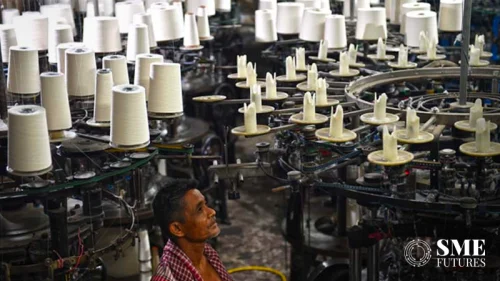The footwear market in India is seeing an upsurge due to growing demand for trendy, fancy and comfortable footwear among the country’s young population. According to Research and Markets, the Indian footwear market, which is growing at a CAGR of 4.5 per cent in the period 2017-2023, is expected to reach USD320.44 billion by the end of the forecast period. Second largest footwear producing market after China, India is highly fragmented with close to 75 per cent production coming from the un-organized sector, including micro, small and medium enterprises.
Rapid urbanization, higher disposable income and growing influence of social media are leading to the changing fashion needs of consumers. Today, the footwear market is closely aligned with consumer spending on fashion accessories. . With increasing trend for active and exercise regimes, demand for athletic shoes has grown among non-sportspersons as well.
The changing trend is also leading to manufacturers widening their product portfolio in order to attract consumers and gain competitive edge.
“The industry is definitely growing, especially in the kids and women segment. Indian men were earlier fond of open footwear, but that has changed. Closed footwear is in the trend and we are one of the top manufacturers in this category,” HS Bahety, founder, Unistar Footwear Pvt Ltd tells SMEFutures.com. In an interaction, Bahety talks about various aspects of this growing market.
Edited excerpts:
What’s your take on the current status of footwear industry in India?
Globally, India is second largest footwear producer, after China. Our country produces 2.2 billion pairs of footwear, accounting for approximately nine per cent of the global annual production, while China controls over 60 per cent of the total production. Out of the
2.2 billion pairs produced in India, about 180 million pairs are exported, while the rest (approximately 95 per cent)meets the domestic demand.
As the market data suggests, and in my opinion, footwear market is on the bright side and growing by 5-6 per cent per year. Once there was a time when people were happy with one or two pair of shoes, but today it’s more of an accessory. Consumers, nowadays, are purchasing footwear as per the occasions and have more pairs than ever. However, the average per capita footwear consumption is as low as ~2 pairs per annum when compared to the global average consumption of 3 pairs, while developed countries average of 6-7 pairs by merchandise. But, the increased consumption power is giving the real boost to the industry.
It is also important to note global conflicts that industries are witnessing. Trade war between the US and China can be beneficial for the Indian industrial sectors. There is a pool of opportunities out there, only thing is we must tap them.
You mentioned that the footwear industry is not able to reap the benefits. Could you please elaborate.
There are immense opportunities out there, but few constrictions are hindering the growth that we expect. There are two-three areas, where the government needs to support us. Firstly, footwear manufacturers are dealing with high taxes. The government imposes 18 per cent Goods and Services Tax (GST) on footwear pricedabove Rs 1,000, which affects almost overall business cycle of a manufacturer – especially if it’s a small and medium enterprise. Tax structure can’t be adjusted anywhere else and becomes a part of our cost, adding to the retail price of the footwear, which has to be ultimately paid by the consumers.
Adding to the woes is GST on labour supply, which also stands at 18 per cent. On the one hand, the government wants to increase the employment opportunities, and on the other hand it imposes high tax structure on manpower supply. This contradict each other. If the government is really serious about job creation, then it should reduce 18 per cent GST to 12 per cent. The GST rate cut will induce more domestic job opportunities and will earn more foreign exchange.
Another area where we are suffering is GST on footwear components. Each footwear is made up of various components such as upper , sole etc. If we buy the components to fabricate the shoe upper, 18 per cent tax is payable whereas the final product is taxable at the rate of 5 per cent (if the MRP of the footwear is under Rs 500). So, this is again hindering the growth of the footwear industry.
Manufacturers strongly demand the restructuring of GST taxation at different level.
What are the other challenges footwear manufacturers are facing?
The footwear industry in India is highly labour intensive and currently employs close to three million people. Out of this, almost 30 per cent are women.
However, there is a major shortage of skilled workforce and that’s why we are lagging behind China. I believe measures taken by the government are not enough in providing the skilled workforce for the sector. People are demanding more and more designs and variations in footwear, however, there are fewer number of institutes for footwear related studies. As far as the question of employment generation is concerned, footwear industry is extremely big.. As per a report released by the Department of Industrial Policy and Promotion, the industry has the capacity to generate 250 jobs for every investment of Rs 1 crore. The government should bring out firm measures to resolve the challenge.
Even after 95 per cent footwear manufactured in India is consumed domestically, imports from China and Taiwan are still hurting the market. How do you view this?
Yes. Majority of footwear production is still consumed by the Indians, and the export ratio is less than 10 per cent. Then industry is reeling under Chinese imports as they dump at lower rates. People also prefer Chinese footwear over local made as they are cheaper and offers wide variety.
But the important thing is that out of the total Indian footwear imports, 63 per cent is Chinese, which have reduced by 295 per cent in last 5 years, according to the Council for Footwear, Leather and Accessories (CFLA). However, the change in GST impositions of five per cent for products up to the trade value of Rs 1,000 has given relief to the customers, traders as well as the sector at large. This in turn has helped us to reduce the Chinese competition drastically. In my knowledge, very few Chinese footwear containers are coming in.
What are the trends you are seeing in the industry?
With the expanding market, the needs of consumers are also changing fast. Rapid urbanization, higher disposable incomes and greater penetration of media have led to changing fashion needs of the consumers. With this, casual footwear segment still dominates the Indian market and accounts for two-third of the total footwear retail market. Men’s footwear dominates, accounting for nearly 58 per cent of the entire Indian footwear retail market. Indian men were earlier fond of open footwear, but that has changed. Closed footwear is now in trend, and we are one of the top manufacturers in this category. While, kids and women segment are also seeing growth.
The designing trends are also changing. Today, the upper that are in fashion is of flynet uppers i.e knitted uppers. PU leather (Polyurethane coated leather) and Suede leather footwear is in demand. Consumers are attracted towards luxury-looking products, which is pushing the domestic manufacturers to be more competitive in their designs. Online sales of footwear have increased manifold over the past five years, giving local manufacturers a competitive platform. Players are convinced that brick and mortar stores still play a strong role in this industry.
International brands are flooding in the Indian market and consumers are shifting towards them, how Indian manufacturers are reacting?
There are few international brands such as Adidas, Nike, Puma that have made a way into the Indian market very well. But again, they have a separate status, separate customer base and altogether separate price range. We are not at all trying to compete with them because most of the Indian brands and manufacturers do not have that kind of set-up and techniques, also marketing and branding can be a crucial business decision. These big brands have big budgets for marketing activities, whereas most of the Indian manufacturers when compared have credit limitations when it comes to settling marketing strategies.
Unistar is among the top 25 shoe manufacturers in India. We have been constantly upgrading ourselves with the changing trends, whether it is in terms of technology, shoe designs, marketing style, or selection of models. We have a set of in-house designers and we have full-fledged laboratory in Bahadurgarh, Haryana, where we perform different parameter tests on our products.
Our road map is to increase the manufacturing capacity and go for backward integration in our company (the process in which a company purchases or internally produces segments of its supply chain). Despite few sectoral challenges, the future of Indian footwear industry looks bright overall and we are looking forward to bringing out the best products for our consumers.











